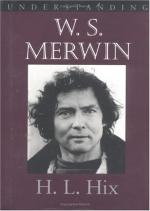|
This section contains 6,749 words (approx. 23 pages at 300 words per page) |

|
SOURCE: "Breaking the Glass: A Pattern of Visionary Imagery in W. S. Merwin," in Chicago Review, Vol. 36, No. 1, Summer, 1988, pp. 65-83.
In the following essay, Clifton discusses Merwin's focus on visionary experiences, the unconscious, and death in his poetry.
After quoting Blake's own words to establish his work as essentially "'Visionary,'" and then defining that term as the "view of the world … as it really is when it is seen by human consciousness at its greatest height and intensity," Northrop Frye suggests an important but largely ignored point for criticism in his essay "Blake After Two Centuries" when he observes that works like Aldous Huxley's The Doors of Perception "seem to show that the formal principles of this heightened vision are constantly latent in the mind," and that it is this constant availability of vision, near at hand but suppressed, which "perhaps explains the communicability of such...
|
This section contains 6,749 words (approx. 23 pages at 300 words per page) |

|


